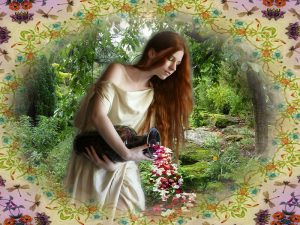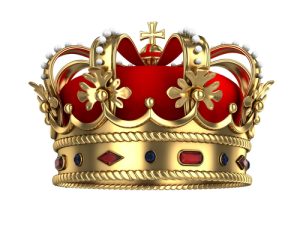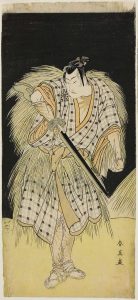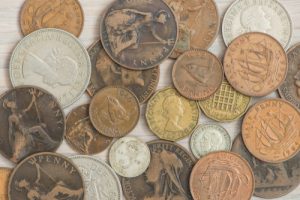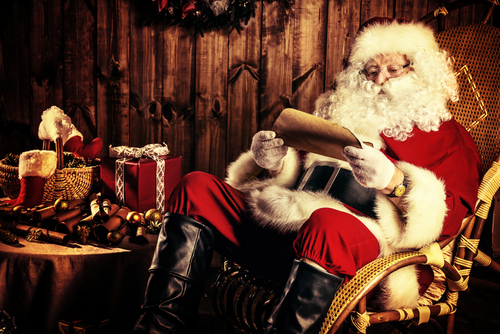
A brief history of Father Christmas
The earliest reckoning of a Father Christmas figure first appearing in Britain was during mid-winter festivals in pre-Christian times. Of course, he wasn’t referred to as Father Christmas then but was just another pagan character who happened to represent the coming of spring. He dressed up in a long, green hooded cloak and would wear a wreath of holly or mistletoe. Hence, today’s Christmas association with holly and mistletoe is something we retain from this ancient Father Christmas.

Image credit: Kiselev Andrey Valerevich/Shutterstock.com
The Saxon ‘King Winter’
When the Saxons invaded Britain in the 5th and 6th century, they brought with them their own Father Christmas character who was known as King Frost or King Winter. Anyone who dressed up as King Winter was welcomed into peoples’ homes, where they would be invited to sit by the fire and be given something to eat and drink. Thus, the custom spawned the tradition of leaving Father Christmas something to eat and drink. Essentially, it was thought that if you were kind to King Winter, life would be kind to you. Thus, in time, Father Christmas became associated with being the bearer of gifts.
A Viking God
In the 8th and 9th century, Britain’s next invaders, the Vikings, began to settle in the country bringing with them their own midwinter traditions. The Viking winter celebration, between the 22nd December to 2nd January, was known as Jultid, which translates to English as Yuletide. It was celebrated as being the time when the Norse God, Odin, visited earth. During Yuletide, Odin, most often depicted as an old, wise, portly, all-knowing, fatherly man with a long white beard, would fly across the sky on his eight-legged horse, Sleipner.
In the adopted British version, like Odin, Father Christmas was robust and rotund but had also developed the superpower of knowing whether children had been bad or good. Also like Odin, Father Christmas could travel magically and be in lots of different places within an instance of time.
Saint Nicholas
By the time the Normans arrived in Britain with their stories of St Nicholas, the creation of Father Christmas was already complete. The first written reference to the entity of Father Christmas is found in a 15th-century carol, which includes the line “Welcome, my lord Christëmas.” From thereafter, Father Christmas was seen as a representation of the spirit of Christmas: that of merriment and benevolence to all. In Tudor and Stuart times, Sir Christmas or Captain Christmas was called upon to preside over the festive entertainment in wealthy households. In 1638, author and dramatist Thomas Nabbes was the first person to illustrate Father Christmas, who he depicted as an old man in a fur coat and cap.
Father Christmas
However, the pagan figure of revelry proved too much for the Puritans who had by now seized control of the British parliament, so in 1644, they banned Father Christmas, along with Christmas itself. Father Christmas was then forced underground but would often appear in secret plays or illegal newspapers under the guise of Old Christmas, where he was used as a representation of what people missed about the festival. It was not until the Victorian times that Father Christmas was truly revived as the spirit of Christmas, embodying all the elements of all his predecessor. By this time he was usually drawn as a jolly, pagan figure in a long, red, blue, green or brown hooded coat.
A Modern-day Santa
By the middle of the 20th century, the British Father Christmas was changing again. This time his depiction became heavily influenced by his American counterpart; Santa Claus. Who had, in turn, had been built on ideas from the 1822 poem by Clement C. Moore; ‘The Night Before Christmas’, the John Nast illustrations it inspired in an edition of Harper’s Weekly in 1881, and by the Coca Cola Company adverts of the 1920s and 1930s.
In Moore’s poem, we see Santa Claus as a combination of the characteristics of Odin, St Nicholas and Father Christmas. From Nash’s drawings, heavily influenced by Moore’s poem, we get the notion that Santa lives at the North Pole, has a list of good and bad children, who he gets letters from. And it was the Coca Cola Company’s adverts of the 1920s and 30s that standardised the colour of Santa’s coat to that of red. Such was Santa’s influence on Father Christmas during the post-war period, that within in a few years, they had more or less morphed into a single entity.
If you thought Father Christmas was just another name for Santa Claus why not check out our post by clicking here.
If you’ve enjoyed reading this post, why not check out more of the articles in the series by clicking the following link: Why do we…….?
